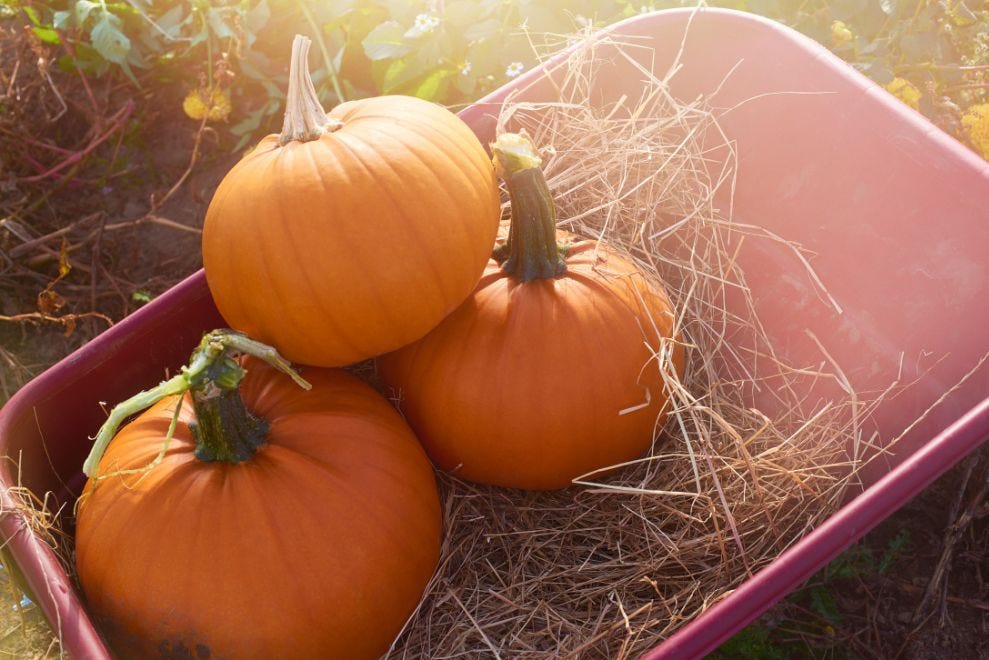
So, to October in the garden – preparing for winter and the coming spring.
Let’s look at the tasks that await us!

Lawns
It’s time to put the lawn to bed in a condition to produce a revitalised sward after the trauma of this last summer.
Mowings with the cutter blade at its highest setting can be made through this month.
Now for the hard bit!
Our lawns have really been through it this summer. What’s needed is ‘scarification’, which involves removing ‘thatch’ – dead grass and other detritus, which involves vigorous treatment with a ‘spring-tine’ rake.
It’s a job best done ‘a bit at a time’, but it’s great exercise!
Aeration
Our lawns will have become compacted, so aeration is important. Again, don’t attempt to do it all at once, but use a garden fork to spike the surface several inches apart. For larger areas you can hire a machine to make life easier.
Oversowing
There is still time for re-sowing after the above treatment. Sow bare patches where the surface has been roughened and sprinkle seed over the rest of the lawn, to replace fine-leaved species which may have perished this summer. It will rejuvenate your lawn next year!

In the Flower Garden
If not done already, it’s time to take down hanging baskets and empty containers of summer annuals. Both spent compost and plants can go in the compost bin as long as not diseased.
Consider replanting hanging baskets with late winter/spring flowering pansies or violas to add some colour and perhaps plant spring bulb displays for containers.
There’s still time to plant autumn bulbs such as tulips, narcissi, hyacinths etc. There is some really good value in garden centre sales but ensure bulbs have not gone soft with signs of fungal infection.
You may have made sowings of forget-me-nots and wallflowers in late summer? If not, you can purchase plants from a garden centre. They look superb in spring combined with bulb displays and the scent of the wallflower blooms is delicious!
Lift tubers and corms of dahlias, begonias and gladioli etc. before we get harsh autumn frosts. Make sure they are dry and store in glasshouse, garage etc. for use next year.
Think too about tender bulbous plants like cannas which should also be lifted and stored frost-free through the winter.
Make sweet pea sowings for early summer flowering – there are always enticing new varieties in the seed catalogues.
Continue to lift, divide and re-plant older herbaceous perennials that have become crowded. It will improve flowering performance – and give you more plants for other areas!
Cut down fading flowering shoots and foliage in readiness for the winter.
Plant perennial plants such as heuchera, lavendula and salvias.

The Vegetable Plot
October is the time of ‘harvest festivals’ and a busy time in the garden to collect all the storable produce.
Cut off tomatoes and peppers at ground level and hang them upside down in the greenhouse or garage. Pick off ripening tomato fruit and store in a dry position, using fruit as it ripens. A ripe banana placed in the vicinity will speed ripening. Alternatively use for making chutney or the green ones for pesto.
Late maturing sweet corn cobs can be frozen for later use and winter squashes stored in a dry shed or garage.
Harvest any pumpkins and squashes now and store inside as the frost will turn them mushy!
Think about making sowings of broad beans like ‘Aquadulce’ and early pea varieties for early summer cropping next year. You can also be planting garlic and onion sets.
Keep a close eye on your winter cabbage, brussels sprouts and other brassicas for signs of pests and diseases.
Fold a leaf over the developing heads of autumn cauliflowers to protect the ‘curds’ from frosts.
Cut back the foliage of asparagus to just above ground level.

The Fruit Patch
Cut back and tie in raspberry canes that have fruited this last summer to increase cropping next year.
As the weather cools yet the soil remains warm, it’s the ideal time to plant ‘bare root’ plants of top fruit (apples, pears etc.) and soft fruit like raspberries, blackcurrants etc. lifted straight from the nursery. The advantage of bare root? Plants are a lot cheaper than those grown in containers!
Do you have an old clump of rhubarb which is not cropping well? Chances are it has become overcrowded so it’s time to lift and split into the individual plants.
Apply the old fashioned but effective method of ‘winter wash’ to the trunks and branches of fruit trees to rid yourself of overwintering pests.

Shrubs
It’s a great time for planting new additions to the garden as ‘bare root’ plants. Good too for planting new hedges.
Prune back shrub roses by a third to reduce damage from ‘wind rock’
Give hedges their final trim before the winter.
Got a favourite shrub and would like another? Now’s the time to take hardwood cuttings to root over the winter.
I’m writing this month’s issue whilst spending a few days in the Lake District and how green and verdant the fields look compared with the parched lands of home in Devon!
So let’s got on with those garden tasks, but don’t forget planning for next year.
Happy Gardening!

